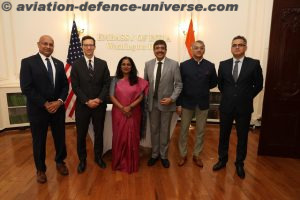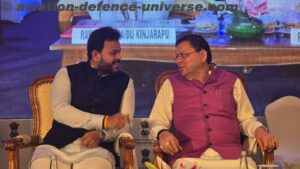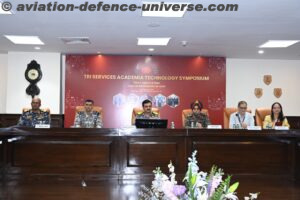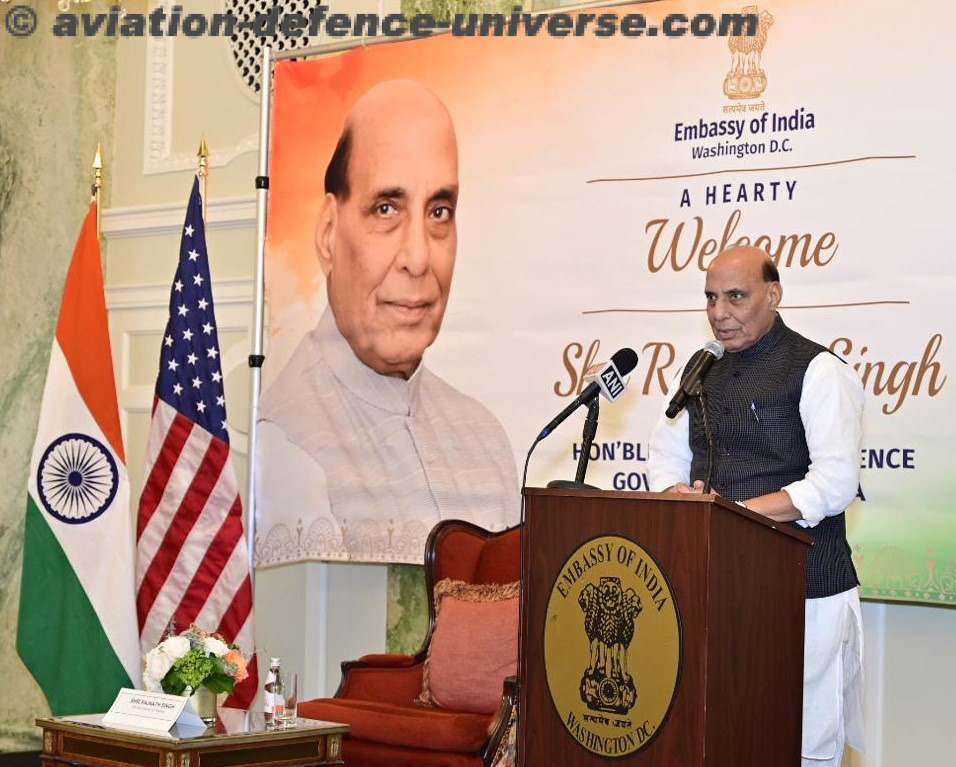
- India and US Sign Key Defence Agreements to Bolster Strategic Partnership
By Sangeeta Saxena
New Delhi. 23 August 2024. During his visit to the United States, Indian Defence Minister Rajnath Singh emphasized the importance of the growing defence relationship between India and the United States. Speaking to the Indian diaspora in Washington on August 22, 2024, Singh reiterated that India and the US are natural allies, poised to collaborate for global peace, prosperity, and stability. His remarks come at a time when both countries are looking to deepen their strategic and defence ties through new agreements and cooperative initiatives.
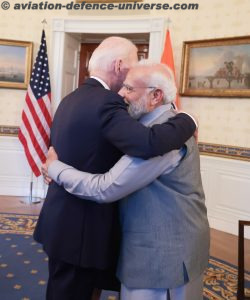
The relationship between Prime Minister Narendra Modi and President Joe Biden exemplifies this dynamic. The two leaders have held multiple bilateral meetings and have met on the sidelines of various multilateral events. Prime Minister Modi has also participated in several virtual summits convened by President Biden, including those for the Quad, I2U2 (India, Israel, USA, and UAE), the Summit for Democracy, and other significant events.
Defence Minister Rajnath Singh arrived in Washington on August 22, 2024, for a four-day official visit to the United States. Addressing the Indian community, he underlined the strong partnership between India and the US, describing it as a crucial alliance that is growing continuously. “Together, India and the US make a formidable force that can ensure peace and stability in the world,” Singh stated.
India and the United States enjoy a comprehensive global strategic partnership that spans nearly all areas of human endeavor. This partnership is driven by shared democratic values, converging interests on a range of issues, and robust people-to-people connections. Regular dialogue between the leaders of both countries plays a crucial role in expanding these bilateral ties, with outcomes from high-level visits significantly strengthening multifaceted relations.
He attributed India’s rising global stature to the leadership of Prime Minister Narendra Modi, noting that India’s voice is now more respected in international fora than ever before. Singh highlighted India’s transformation from being among the ‘Fragile Five’ economies in 2014, as coined by Morgan Stanley, to being one of the ‘Fabulous Five’ economies today. He cited Morgan Stanley’s recent report predicting that India will become the world’s third-largest economy by 2027, reflecting the country’s resilient economic growth, especially through the COVID-19 pandemic.
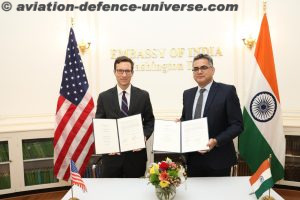 India-US defence cooperation is built on the “New Framework for India-US Cooperation,” renewed for ten years in 2015. In 2016, this relationship was elevated to a Major Defence Partnership (MDP). Subsequently, in 2018, India was moved into Tier-1 of the US Department of Commerce’s Strategic Trade Authorization license exception, which has further enhanced defence cooperation between the two nations. The defence partnership between India and the United States is multifaceted and includes regular institutionalized bilateral dialogues, military exercises, and defence procurements. The 2+2 Ministerial Dialogue stands at the apex of these dialogue mechanisms, co-chaired by India’s Minister of External Affairs and Minister of Defence, and the US Secretary of State and Secretary of Defence. This dialogue provides strategic guidance on political, military, and defence matters.
India-US defence cooperation is built on the “New Framework for India-US Cooperation,” renewed for ten years in 2015. In 2016, this relationship was elevated to a Major Defence Partnership (MDP). Subsequently, in 2018, India was moved into Tier-1 of the US Department of Commerce’s Strategic Trade Authorization license exception, which has further enhanced defence cooperation between the two nations. The defence partnership between India and the United States is multifaceted and includes regular institutionalized bilateral dialogues, military exercises, and defence procurements. The 2+2 Ministerial Dialogue stands at the apex of these dialogue mechanisms, co-chaired by India’s Minister of External Affairs and Minister of Defence, and the US Secretary of State and Secretary of Defence. This dialogue provides strategic guidance on political, military, and defence matters.
Rajnath Singh also discussed the Indian government’s significant achievements in poverty alleviation, inflation control, and economic stability. He noted that 25 crore people have been lifted above the poverty line, retail inflation has dropped to a five-year low of 3.54%, and foreign exchange reserves have reached a historic high of $675 billion.
The Defence Policy Group (DPG), headed by the Defence Secretary of India and the Under Secretary of Defence (Policy) from the US, serves as a platform for a comprehensive review of all defence dialogues and mechanisms. The 17th DPG meeting was held in Washington D.C. in May 2023. Defence procurements from the US are growing and now amount to nearly USD 20 billion. Major US-origin platforms used by India include the C-130J, C-17, Apache, Chinook, MH60R helicopters, and P8I maritime surveillance aircraft. Other bilateral dialogue mechanisms include the Defence Production and Procurement Group, Joint Technology Group, Maritime Security Dialogue, and Industrial Security Summit. Since 2022, three US Maritime Sealift Command ships have visited Indian shipyards for repairs and allied services under commercial contracts.
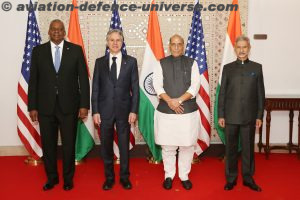
Several important defence agreements provide the framework for interaction and cooperation between the two nations. These include the Logistics Exchange Memorandum of Agreement (2016), Communications Compatibility and Security Agreement (2018), Industrial Security Agreement (2019), and Basic Exchange and Cooperation Agreement (2020). The Memorandum of Intent for Defence Innovation Cooperation (2018) further supports this collaboration. In May 2023, the India-US Defence Industrial Cooperation Roadmap was concluded, aiming to fast-track technology cooperation and co-production in areas of mutual interest. Following this, the India-US Defense Acceleration Ecosystem (INDUS X)—a network of universities, incubators, corporations, think tanks, and private investment stakeholders—was launched in June 2023 to promote innovation in defence technology.
Focusing on the defence sector, Singh elaborated on the steps taken towards achieving ‘Aatmanirbharta’ (self-reliance) in defence manufacturing. He mentioned the notification of Positive Indigenisation Lists, which include over 5,000 items aimed at boosting domestic production of defence equipment. He also highlighted the surge in defence exports from Rs 600 crore to over Rs 21,000 crore and the remarkable growth of start-ups in India, which have increased from around 400 in 2014 to 1.20 lakh today. These accomplishments, he said, are the result of the government’s strategic policies and planning.
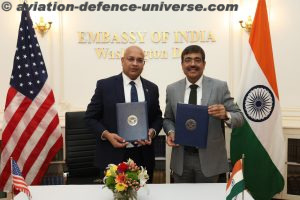 Coinciding with his arrival, senior defence officials from India and the US signed two significant agreements: the Security of Supplies Arrangement (SOSA) and a Memorandum of Agreement regarding the Assignment of Liaison Officers. These agreements mark a critical step in further strengthening the defence cooperation between the two nations.
Coinciding with his arrival, senior defence officials from India and the US signed two significant agreements: the Security of Supplies Arrangement (SOSA) and a Memorandum of Agreement regarding the Assignment of Liaison Officers. These agreements mark a critical step in further strengthening the defence cooperation between the two nations.
Military-to-military exchanges between India and the US are extensive, involving high-level visits, joint exercises, training courses, and regular service-specific bilateral mechanisms. India and the US conduct the highest number of joint military exercises among their respective partners, which continue to grow in scale and complexity. Notable bilateral exercises include Yudh Abhyas (Army), Vajra Prahar (Special Forces), Malabar (Navy), Cope India (Air Force), and Tiger Triumph (tri-services). Additionally, the two countries participate in several multilateral exercises such as Red Flag, RIMPAC, CUTLASS Express, Sea Dragon, and Milan. In a historic event, the INS Satpura became the first Indian naval ship to visit the US mainland, docking in San Diego in August 2022 as part of Azadi Ka Amrit Mahotsav celebrations. In April 2022, India joined the multilateral Combined Maritime Force (CMF) based in Bahrain as an Associate Partner.
Counterterrorism cooperation is another pillar of the bilateral partnership, featuring information exchange, capacity building, operational cooperation, and regular dialogue through the India-US Joint Working Group on Counter-Terrorism. In 2017, both countries initiated a dialogue on domestic and international terrorist designations, with the latest Joint Working Group on Counter-Terrorism and Designations Dialogue held in New Delhi on December 13, 2022.
Cybersecurity cooperation between India and the US is governed by the India-US Cyber Framework, signed in September 2016. The India-US Cyber Dialogue was held in Washington D.C. in September 2022, led by the respective Deputy National Security Advisors. India also participated in the US-led Counter Ransomware Initiatives meeting in Washington D.C. in November 2022.
In the realm of space cooperation, the India-US Civil Space Joint Working Group last met in Washington D.C. on January 30-31, 2023, co-chaired by the Scientific Secretary of ISRO and the Associate Administrator of NASA. The two agencies are developing a microwave remote sensing satellite for Earth observation, the NASA-ISRO Synthetic Aperture Radar (NISAR), scheduled for launch in early 2024 from Shriharikota, India. ISRO has also utilized NASA’s Deep Space Network Antenna support for its Chandrayaan-1, Mars Orbiter Mission (MOM), Chandrayaan-2, and Chandrayaan-3 missions.
ISRO and NASA have successfully implemented a Professional Scientific Personnel Exchange Programme in Earth observation applications, under the framework signed in April 2017. Additionally, ISRO has launched over 200 US satellites aboard the Polar Satellite Launch Vehicle (PSLV) as co-passengers. In June 2023, ISRO signed the Artemis Accords with NASA to participate in peaceful and sustainable civil exploration of outer space. The two agencies have agreed to enhance cooperation in human space flight, including developing a strategic framework for collaboration and mounting a joint effort to the International Space Station. NASA will also train Indian astronauts, and a Commercial Space Working Group will be established under the Civil Space Joint Working Group to enhance collaboration between the US and Indian private sectors.
The Initiative for Critical and Emerging Technology (iCET) was launched by the National Security Advisors of both countries in Washington, D.C., on January 31, 2023, to facilitate strategic technology collaborations in critical and emerging technologies. This initiative focuses on co-development and co-production and aims to connect the respective innovation ecosystems, particularly in areas such as AI, quantum computing, telecommunications, space, biotechnology, semiconductors, and emerging defence technologies. The second iCET meeting was held in New Delhi on June 13-14, 2023.
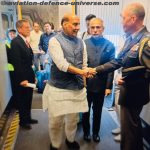 During his visit, Rajnath Singh is set to meet with US Secretary of Defence Lloyd Austin and National Security Advisor Jake Sullivan to discuss ongoing and future defence collaborations. He will also chair a high-level round-table meeting with the US defence industry. These engagements underscore the growing importance of the India-US defence partnership in promoting global security and stability. With the signing of new defence agreements and continued high-level discussions, the India-US Comprehensive Global Strategic Partnership is poised to reach new heights.
During his visit, Rajnath Singh is set to meet with US Secretary of Defence Lloyd Austin and National Security Advisor Jake Sullivan to discuss ongoing and future defence collaborations. He will also chair a high-level round-table meeting with the US defence industry. These engagements underscore the growing importance of the India-US defence partnership in promoting global security and stability. With the signing of new defence agreements and continued high-level discussions, the India-US Comprehensive Global Strategic Partnership is poised to reach new heights.
The visit comes in the backdrop of the growing momentum in India-US relations and defence engagements at multiple levels. The visit is expected to further deepen and broaden the India-US Comprehensive Global Strategic Partnership. Rajnath Singh will also chair a high-level roundtable meeting with the US defence industry on the ongoing and future defence collaborations. He will also interact with the Indian community during the visit.
Overall, the India-US partnership continues to thrive, encompassing diverse areas such as defence, cybersecurity, space exploration, and emerging technologies. This partnership is poised to deepen further as both countries explore new avenues for cooperation and collaboration in the coming years.

































